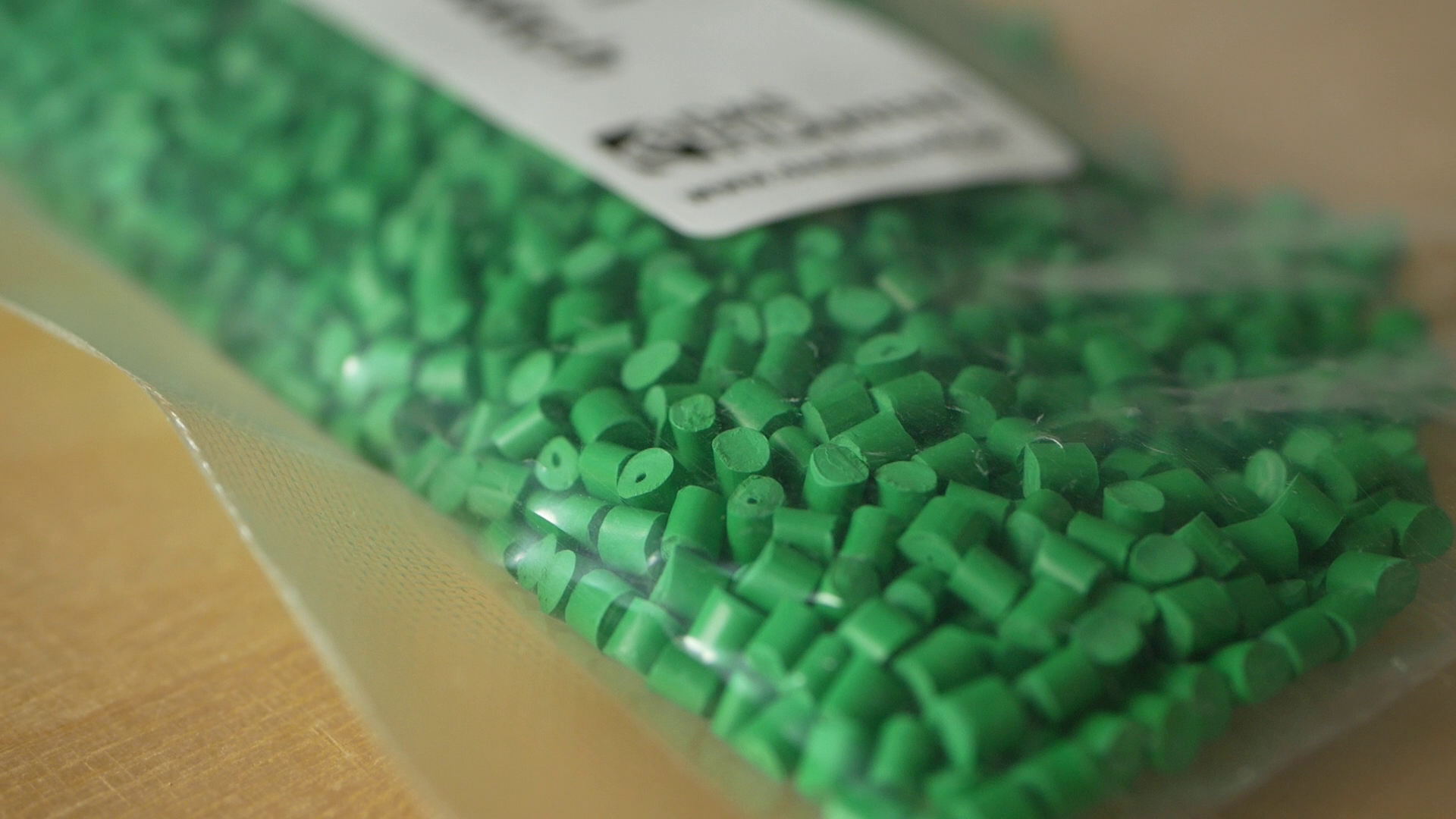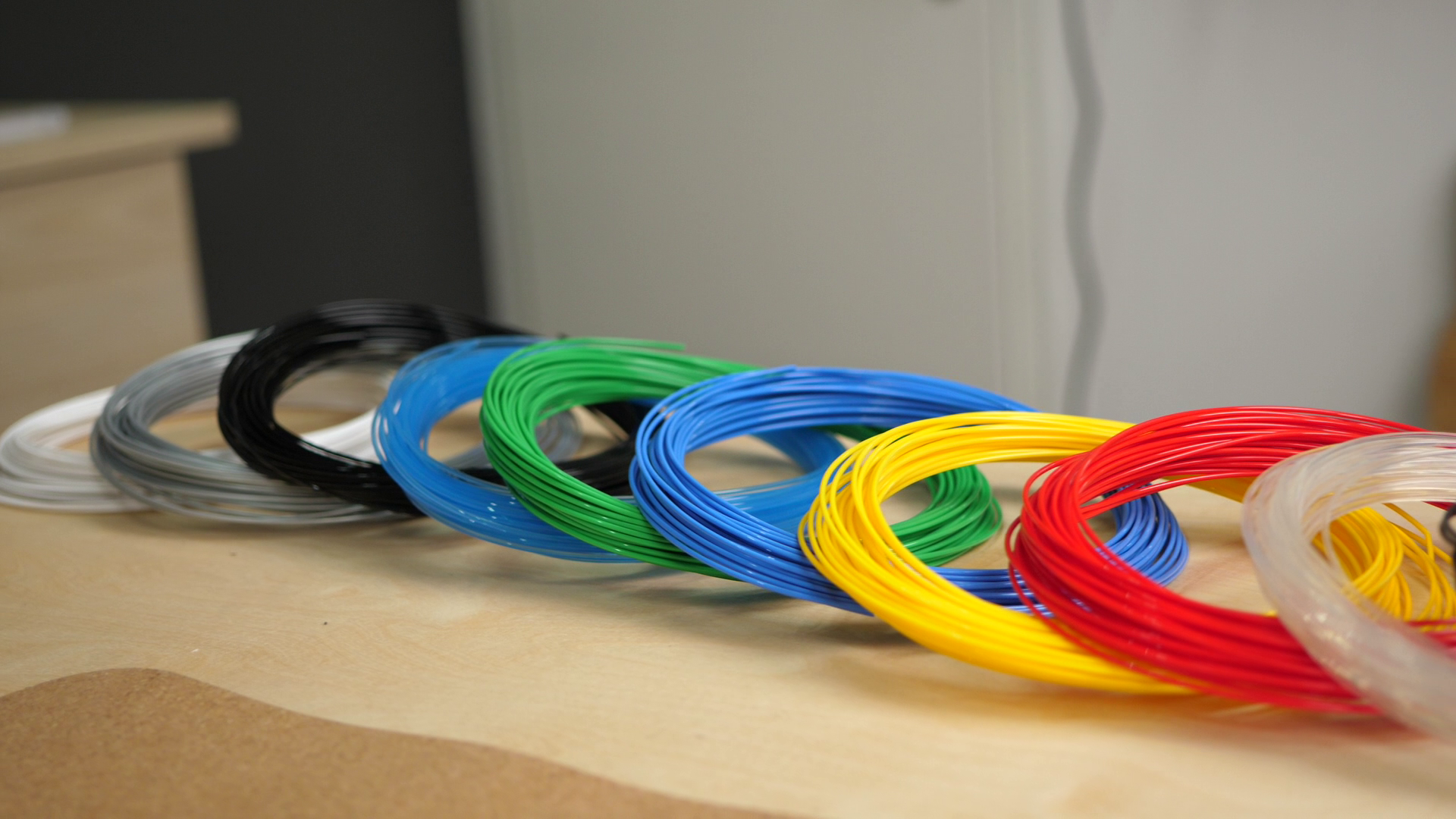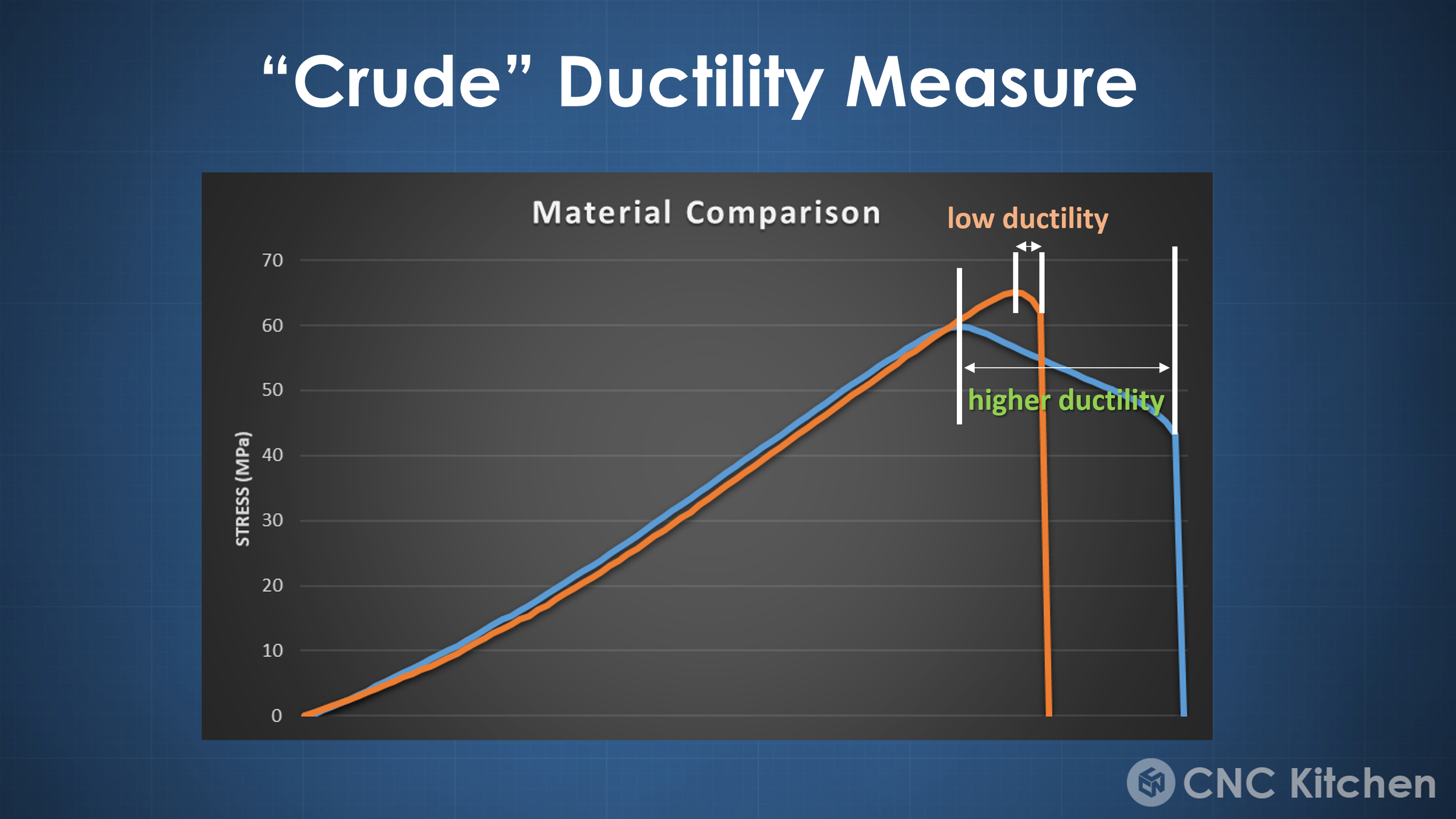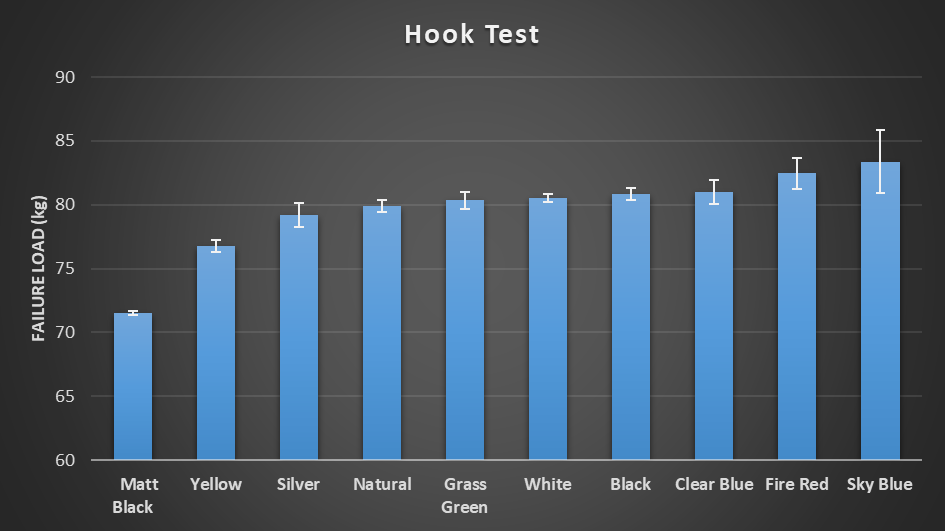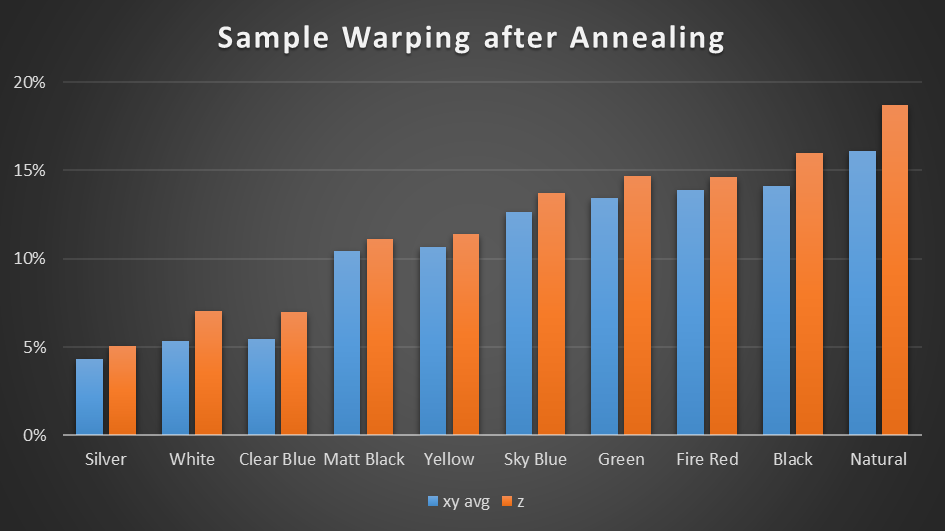How the color of PLA filament influences 3D printed part strength
Years ago I was at an injection moulding company discussing a part with very tight tolerances where the owner told me how different their material shrinkage was depending on the color they use and that blue was the worst! Ever since that day I wondered if this is the same with 3D printing filament? Does it’s color affect the performance of our parts? Most of you will know that there are a ton of parameters that influence the strength of your 3D prints.
More infill and perimeters, stronger parts
Higher extrusion temperatures make better layer adhesion, yet worse quality
And of course, the market of different filament types is huge and there is PLA, PETG, Nylon, ABS, and even sub-variants like PLA+ that modify the way a material is printable and how strong it is. Yet have you ever considered if the color of filament you purchase could have an influence on how strong your parts actually are?
So when filament manufacturers make material, they usually buy uncolored resin pellets in bulk and then mix them in the extruder itself with a small amount of pigment in the form of a so-called Masterbatch. This Masterbatch are pellets that consist of highly concentrated pigments, particles, fillers and other additives, which then get dispersed into the molten polymer. These color the filament and even can give it unique looks, like a silk finish, glitter, or a matt appearance. The components responsible for color can range from organic and inorganic pigments to carbon for black and Titanium Dioxide for white. Depending on what’s added, this process will also change the properties of the final material. Yet, if we even find a mechanical data sheet for a filament, the properties that are stated are usually generalized and not specific for a color. But there are differences! For my part, I always try to stay away from matt and silk materials because I often had problems with material flow, proper layer adhesion, and quality. Other than that, I’m honest here I usually assumed that the differences are negligible and never chose a certain color of material for a project or strength test because I thought it performed better or worse.
PLA Masterbatch
A couple of years ago, I read the first publication on the impact of PLA color on mechanical properties and just recently, another paper was released that did a similar investigation for PLA and ABS. Both showed a clear influence of color on strength, stiffness, impact resistance, and ductility, ranging up to a 30% difference in properties depending on the material color.
Papers and Articles
https://www.mdpi.com/1996-1944/15/19/7039
Since I don’t fully agree with the methods they applied and of course, because I also was wondering the same thing for a while, I finally performed my own, proper investigation. For that, I purchased ten different PLA filament colors from the German filament manufacturer dasFilament. I talked to them, making sure that they always used the same type of pellets and that the only difference between the samples was the used masterbatch. I got natural PLA without any pigments, then the typical black and white colors, as well as a matt black variant. Then I got a regular blue and also a translucent blue. The only other specialty filament I got was silver. The rest were standard red, green, and yellow. My results will, of course, not be universally applicable for any other manufacturer because they probably use different masterbatches and even base resins but will give us an idea if color is something to worry about or not!
Filament Samples
The samples that I chose to print were tensile specimens to test material strength and layer adhesion. Everything with a 0.4 mm nozzle at 0.2 mm layer height. The horizontal ones used 5 perimeters, so all the extrusions in the test section are aligned with the load, the standing ones used one perimeter and 100% infill. Then I, of course, printed a testhook from each of the materials, which is not only a more realistic part but is also loaded with tension and bending and will tell us a lot about the general material performance. This one had 3 perimeters and 30% cubic infill which is a setting I use for many mechanically loaded parts. I also printed 3 impact specimens, with 8 perimeters and 100% infill, that will give us an idea of how tough a material is when it’s loaded quickly. And finally, I printed a Benchy to see if we have a difference in printing quality as well as an annealing test part. This part will be annealed in the oven at 100°C after printing because I was really curious if colors make a difference in the amount of deformation we get. The parts were printed in a sequential order, so every group by itself making sure that layertimes and cooling was very consistent. Well, until I had everything set up because I noticed that the printhead of my VORON 2.4 was bigger than I expected, knocking parts off and resulting in layershifts and failures in my first test prints.
Since I usually treat filament colors, especially from the same supplier, as interchangeable, I used exactly the same G-Code for all ten prints. I printed the PLA at around 204°C nozzle, 60% cooling, and 60 °C bed temperature, with open doors, so at around room temperature on my Voron 2.4. Some will argue that they tune every color of their filament but in my opinion, that would defeat the purpose of this investigation in finding out how interchangeable different colors are!
Job Layout
The general quality of the parts was very nice, as you would expect when working with PLA. The only notable thing here was, that the white filament hugely amplified any inconsistencies in the print, which is also the reason why I rarely print parts in white.
3D Benchys
So we’ve got our tensile samples, our hooks, the notched impact samples, and finally, the annealing test. I first started with the horizontal tensile samples, which I put one after the other into my DIY universal test machine and loaded them at a constant speed until they failed. I’ll always start with the weakest color and walk my way up to the strongest one. Matt Black was, almost as expected, the worst and failed on average at 60 MPa. Green came next at 62 MPa and the yellow samples failed on average at 63 MPa. Regular black was a bit stronger and ultimately failed at 64 MPa. Red, Silver, Blue, and the natural filament all were able to bear around 65 MPa until they broke. The white and clear blue materials were the strongest and failed at 68 MPa, which is 15% stronger than the worst color, matt black.
Axial Strength
Yet strength isn’t everything. Some materials yield quite a bit after their load limit is reached, while others just break after reaching that point, making them quite unpredictable. Even though I don’t have a real extensometer on my tensile test machine, we can still take a rough look at how ductile a material is, so how much it yields, before it fails, by checking how long it survived after reaching the maximum load.
How I analyzed Ductility
The red material was the most brittle. Then came all the other materials, and matt black as well as yellow were the most ductile ones, yielding over 400% more than the red material. I would have expected that more ductile materials are weaker but besides the matt black material that was weak but yielded significantly, there wasn’t a clear correlation observable.
Crude Ductility Analysis
With the lying samples, we’ve already seen that filament color really makes a significant difference, but what about the very critical layer adhesion of our 3D printed parts? So I again tested three samples for each of the colors and these were printed standing. The silver parts had the worst layer adhesion with only 31 MPa, which is just half of the strength of the lying specimens. Next came, as expected, matt black with 32 MPa. Clear blue wasn’t that much better and only held 35 MPa. Yellow and Grass Green came next, both with 38 MPa, which is already 60% of the reference strength. Blue, Natural and black were able to bear 40, 41 and 42 MPa and the white and red samples had the best layer adhesion with 45 and 46 MPa reaching around 70% of the reference strength, which is quite good!
Layer adhesion samples
Let’s next take a look at the impact performance of the different colored PLA. I didn’t expect a lot because PLA is pretty well known for not being very tough on impact but maybe we can still see a significant difference? The setup is quite simple. The notched samples are held in a vice at the bottom of the machine. Then, a hammer, with a known energy strikes the sample. The tougher a material the more of the energy of the hammer it will absorb and the less far it will swing upwards, which is tracked by a drag dial.
Sample moments before the impact
Red, clear blue, blue, black, white, natural, and green all behaved very similarly, with an average impact strength of 5 kJ/m². The Yellow and Matt Black samples were around 40% tougher than the worst samples, with around 6.5 kJ/m² impact strength. Silver stood significantly out and was twice as strong as the first samples and reached 9 kJ/m² which is a significant difference! So even though layer adhesion wasn’t stellar, silver can take a beating!
IZOD-like impact Test
We have already seen that color can make a significant difference in individual properties, but does that really make a big difference on a more realistic part, where axial strength, layer adhesion, and ductility are important in their combination and this is what I wanted to show with my hook samples. Almost as expected, the matt black hook was the weakest, breaking at only 72 kg of load. Next came the yellow sample that snapped at 77 kg. Silver was a bit stronger, failing at 79 kg. Natural, green, white, black and clear blue were almost similarly strong, breaking between 80 and 81 kg. The red sample was able to bear 15% more load than to worst hook failing at 82 kg and blue was the strongest, failing at a whopping 83 kg and therefore being 17% stronger than the matt black part. If we compare these values with the results from the tensile test, we see that they correlate quite well and probably differ because layer adhesion and shear resistance play a more important role on the hook.
Hook Strength
Let’s finally take a look at the annealing suitability of different colors. To anneal PLA you put your parts in a 100 °C oven for half an hour and then let them cool down slowly. This increases the crystallinity of the material and especially improves the heat resistance of PLA from around 60 °C to over 170 °C. This sounds great but it comes with the huge problem that parts usually warp horribly, making them almost unusable after the process. Even though there are special types of PLA, with less of that tendency I wondered if the used pigment also plays a role. I measured all of the samples before annealing, aligned them on a baking sheet and cooked them. I was able to easily spot that all samples deformed dramatically yet there seemed to be differences. In the past, I thought that warping from annealing comes due to a density change during crystallization, but I’m quite sure now that that was total bullshit. I now think that the deformation is a result of the trapped stresses from printing. The molten material gets squished in z, when it gets laid down and stretched within the printing plane, because it gets bonded onto the previous layer. These internal stresses are released, when you heat up the parts, so they contract in x and y but expand in z, which is exactly what we see on our test samples. But the differences in results were way bigger than I thought!
Silver, white, and clear blue only deformed by 4 to 7%. All other colors deformed by 10% or more! The natural sample was the worst warping by 19% in the z-direction! So if you consider annealing for your PLA parts, maybe try out different colors and see how your results change! Printing slowly also helps, but that’s a topic for another video.
So these were the results! Does the color of your 3D printing filament impact the strength of your parts? Yes, it does! Is it significant? Kind of. The tests showed that especially the specialty filament with the matt finish showed significantly less strength on average. The rest are kind of comparable yet still with differences in properties of up to 400%. It’s hard to find an overall winner because some properties contradict each other. Clear blue has the highest tensile strength yet shows one of the worst layer adhesions. The red material had great layer adhesion but was very brittle, and so on. Of course, my samples were just from one manufacturer with a limited range of colors. But since these results already vary in only the tensile properties up to 50%, there will be even more significant differences between different brands of material even though all say PLA on the package. The results were really interesting and reminded me to be more careful when comparing the properties of materials in the future. The takeaway for you should be that if you have problems with a material, maybe just try out a different color or brand because even within a polymer, there can be huge differences. And when it comes to the mechanical properties of your parts, maybe stay away from specialty colors or finishes if they aren’t necessary for your project!

